A Myth Known as Mars (psst, NASA's not going there, pass it on)
Dear Readers:
Many of you know that I've recently taken NASA Administrator Jim Bridenstine and other highnesses in the agency to task for not being able to talk about plans to go back to the moon (this time to stay) without mentioning Mars in the same breath. My unhappiness over this tendency is pretty simple: Not only do I not like being told a myth unless the teller is a Tolkien type of tall tale spinner, I don't like young people to be the victim of untruths told again and again until even the non-truth sayers think they're telling the truth.
 Mr. Tolkien, Myth-Teller, whose wonderful books were fiction.
Mr. Tolkien, Myth-Teller, whose wonderful books were fiction.
So here is the truth: NASA has no plans now, nor has it ever had plans, nor does it have a plan to have plans to send humans to Mars. As of right now, it isn't going, not with humans, and if you're depending on NASA to get you there, you are going to have a very long wait, sorry. I'll list below some of the things the agency would have done already if it was going to send humans to Mars and they've done none of them.
NASA Aministrator Jim Bridenstine is a very nice man and a competent manager and also very smart. I know him and admire and respect him. But if all that is so, why does he and others in NASA and nearly every person who has anything to do with human spaceflight in the federal government keep talking about going to Mars when they have orders to go to the moon? One reason is because they are victims of an illusion promoted by a billionaire astronomer - sort of a star-gazing Bernie Madoff - more than a century ago that just won't go away. Let me explain why that is as best as I am able in a very short manner which admittedly might miss a few nuances, and let me also provide evidence to you why this astronauts to Mars thing is all a hoax even though the hoaxers (including the original one) don't necessarily understand they're hoaxers and may even think they are telling the truth (bless their hearts).
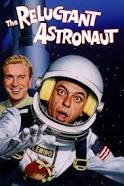 Here is Don Knotts, a fellow West Virginian, playing an astronaut
Here is Don Knotts, a fellow West Virginian, playing an astronaut
that I'm including just because...
Recently, I had cause to research for a screenplay one Clyde Tombaugh, a nerdy but persistent fellow who discovered the dwarf planet Pluto in 1929 (just in time for the Depression but hey).
 Clyde TombaughIn the process of studying Clyde's experiences, I ran across another interesting story, that of Percival Lowell and his secretary and mistress Wrexi Leonard who would become the first American female professional astronomer.
Clyde TombaughIn the process of studying Clyde's experiences, I ran across another interesting story, that of Percival Lowell and his secretary and mistress Wrexi Leonard who would become the first American female professional astronomer.
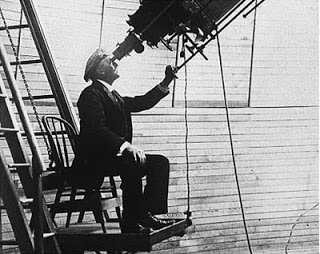 Percival Lowell at his telescope in his observatory
Percival Lowell at his telescope in his observatory
 Wrexi Leonard making her own independent observations
Wrexi Leonard making her own independent observations
at the Lowell Observatory
Dr. Lowell was a very rich member of the Lowell family, a bunch of Boston Brahmins who were rumored to only talk to the Cabots who only talked to God. His sister was a cigar-smoking poet and also an avowed Lesbian (this was during the Gilded Age when Victorian mores were still in effect so she truly didn't care what anybody thought). His brother was the President of Harvard.
 Amy Lowell, Percival's sisterWith such siblings, I guess you could say that Percival came from interesting stock. On the other hand, when you're as rich as the Lowells were, I suppose being interesting might be somewhat natural.
Amy Lowell, Percival's sisterWith such siblings, I guess you could say that Percival came from interesting stock. On the other hand, when you're as rich as the Lowells were, I suppose being interesting might be somewhat natural.
Anyway, after exploring the sexual mores of the ladies of Asia and writing titillating memoirs about his experiences, Percival decided his next pursuit of the good life was to become an astronomer. He therefore constructed the Lowell Observatory in Arizona, dragged poor Wrexi out there with him, and got to work. Before long, he discovered Mars. Well, not really, as the planet had been known since ancient times but sort of because he saw it in ways nobody had ever seen it before.
 One of Percival Lowell's many drawings of Mars
One of Percival Lowell's many drawings of Mars
Dr. Lowell (an honorary title) studied Mars every time the clouds cleared from his hilltop observatory above Scottsdale. It wasn't long before he saw some odd features on the red planet and the more he looked at them and drew them, the more he was convinced he was seeing signs of present or past intelligent life. Night after night, he drew what he saw which were lines that streaked across the planet, some of them intersecting in smudgy places as if on purpose. Before long, he was certain that what he was seeing were canals and the intersections were surely oases where the beings who had dug the canals were living. Wrexi (bless her heart) worked very hard to become a competent astronomer and also studied Mars but didn't see what her boss was seeing. Still, she kept her more accurate observations pretty much to herself and praised her Percival for his astonishing ability to see what nobody else could see. That's just the kind of woman she was but, that said, I'm pleased to report she was no passive wallflower. The Mexican and the French Astronomical societies gave her awards for her work.
But back to Percival Lowell.
Armed with what he believed was evidence of Martians building canals to transport water from the poles in order to sustain their civilization which was facing (or had faced) enormous climate change (hmmm...), Lowell wrote many books on these amazing lines and what they meant. He even went on the lecture circuit and, before long, Percival Lowell was something of a pop star of his age and Mars grew into a symbol of life on the edge that was eagerly clasped to its bosom by a repressed society which was thrilled that there was someone out there besides themselves who was probably equally miserable but had done something about it.
 Some books, mostly about Mars, by Percival Lowell
Some books, mostly about Mars, by Percival Lowell
A careful reading of his writing (difficult as it's pretty dense stuff) shows it isn't entirely clear that Lowell believed his own hype. Actually, he saw that Europe was heading pan over skillet for the Great War and it was his hope that his Martian chronicles would demonstrate that people were better off cooperating in the face of disaster than killing one another off. Nonetheless, the Europeans saw fit to kill one another off by the millions which so disappointed Lowell that he actually died. Well, it may be that something else killed him, maybe his battleaxe of a wife since she was so jealous of Wrexi (my own theory completely devoid and utterly absent of any evidence) but nonetheless Lowell went to the great Mars in the sky, leaving his observatory to struggle on until Clyde showed up but that's another story. Wrexi, by the way, was thrown out on the street by Lowell's wife but did fine other than ending up in the poor house (literally).
 Wrexi's tombstone. She died poor and alone.Lowell's legacy was Mars, or the misunderstanding of what Mars really was, and his purplish prose about what he thought he saw spawned a vast array of fiction including Wells' War of the Worlds, Heinlein's Stranger in a Strange Land, and Bradbury's The Martian Chronicles. Mars in the minds of so many readers became sort of a mini-Earth, or a place where another Earth might rise, and where humans should aspire to go because it was, well, Mars which beckoned with open arms. Besides these literate, exciting books, there came thousands and thousands of tales in book or film form set on a fictional Mars, nearly all of it grown straight out of Percival Lowell's imagination while he peered through his telescopes atop an Arizona mountain (the canals, by the by, might have been the reflection of the veins in his eyes). Lowell's prose was so romantic and his lectures so interesting that, over time, in nearly everyone's head Mars became not what it actually was but what everyone wanted it to be.
Wrexi's tombstone. She died poor and alone.Lowell's legacy was Mars, or the misunderstanding of what Mars really was, and his purplish prose about what he thought he saw spawned a vast array of fiction including Wells' War of the Worlds, Heinlein's Stranger in a Strange Land, and Bradbury's The Martian Chronicles. Mars in the minds of so many readers became sort of a mini-Earth, or a place where another Earth might rise, and where humans should aspire to go because it was, well, Mars which beckoned with open arms. Besides these literate, exciting books, there came thousands and thousands of tales in book or film form set on a fictional Mars, nearly all of it grown straight out of Percival Lowell's imagination while he peered through his telescopes atop an Arizona mountain (the canals, by the by, might have been the reflection of the veins in his eyes). Lowell's prose was so romantic and his lectures so interesting that, over time, in nearly everyone's head Mars became not what it actually was but what everyone wanted it to be.
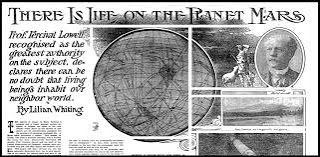 And there you go!But then came a violent correction of Lowell's Martian dreams in the form of the truth.
And there you go!But then came a violent correction of Lowell's Martian dreams in the form of the truth.
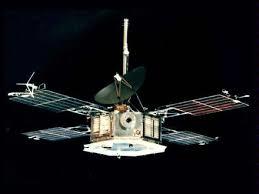 Mariner IV - Dream SlayerIn 1965, NASA' s Mariner IV flew past Mars and took photos and other measurements. What it sent back shocked scientists and lay people still awash with Lowellian dreams of a ruddy but livable world. The photographs revealed only a tortured plain of craters and dirt. Moreover, the flyby confirmed that the Martian atmosphere was only about 1% of Earth's and almost entirely carbon dioxide. The planet also had no magnetic field. In other words, Mars was a dead planet. Dead, dead, dead.
Mariner IV - Dream SlayerIn 1965, NASA' s Mariner IV flew past Mars and took photos and other measurements. What it sent back shocked scientists and lay people still awash with Lowellian dreams of a ruddy but livable world. The photographs revealed only a tortured plain of craters and dirt. Moreover, the flyby confirmed that the Martian atmosphere was only about 1% of Earth's and almost entirely carbon dioxide. The planet also had no magnetic field. In other words, Mars was a dead planet. Dead, dead, dead.
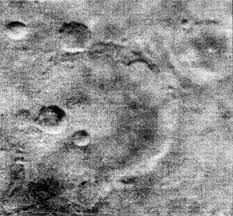 Wait a minute, Mariner IV... Can this be right? This is Mars?The midget planet (only one third the size of Earth) was now known to be nothing but a battered old red rock located far, far away but NASA (bless its heart for persistence) labored on in its study of the place but sadly now with its chastened dreams of a little globe somewhat like Earth totally crushed.
Wait a minute, Mariner IV... Can this be right? This is Mars?The midget planet (only one third the size of Earth) was now known to be nothing but a battered old red rock located far, far away but NASA (bless its heart for persistence) labored on in its study of the place but sadly now with its chastened dreams of a little globe somewhat like Earth totally crushed.
Lowell's dreamy depictions of Mars and all the fiction that had been built up around it, however, proved extremely difficult to suspend and, very soon, the ancient red corpse was being resurrected as a place where humans absolutely needed to go. This time, it was by none other than Dr. Wernher von Braun, something of a dreamer himself, who put Mars back up on its pedestal with a rhetorical stick up its back to hold it up. This, oddly enough, was because of the Apollo moon program which, after an initial rush of excitement after the first landing and the thrill of the Apollo 13 rescue, quickly lapsed below the fold in interest by a bored public.
 My cat Wyatt being bored like the American public. I am
My cat Wyatt being bored like the American public. I am
including this because he's also cute (so is the American public)As an aside, what could have happened at this point was that NASA and the American intelligentsia might have said to themselves, "You know, these Apollo flights have been great and we've learned a lot but they've kind of run their course with the present technology. Let's pause, consider what we've learned, and in the meantime slowly and responsibly build more robust systems to go to the lunar surface so that we might prosper from our success..."
 Thinking like the Thinker, a somewhat untested process in the
Thinking like the Thinker, a somewhat untested process in the
United States overall space programBut nooooo.
Before we scarcely got there, the moon flights were cancelled along with Dr. von Braun's extremely successful heavy lifting Saturn V rocket. Hurt by this rejection, the doctor latched onto Mars and waxed eloquently on it as a substitute destination. To get there, he conjured up a multi-tiered approach of building a space shuttle, then a space station, and then nuclear rocket engines that would propel twin spacecraft and their landers to the small red planet. He said to anyone who would listen that Mars was the "next moon" and so he prepared his pitch to the powers that be and it was a good one, too.
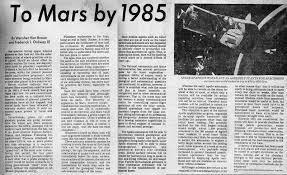 Dr. von Braun's Hail Mary Pass to MarsUnfortunately...
Dr. von Braun's Hail Mary Pass to MarsUnfortunately...
The day after Dr. von Braun made his presentation on going to Mars to Vice President Agnew (soon to resign for taking bribes) and Congress (nobody resigned even though, well, you know), Mariner VII swept by Mars and revealed, yep, Mariner IV wasn't kidding. Mars was not only dead but it was really, really dead. Von Braun was therefore summarily dismissed, his presentation tossed in the trash can, and any idea of going to Mars was forgotten.
 Thank you, Dr. von Braun.
Thank you, Dr. von Braun.
We will consider your proposal carefully - Congress.
But not really. NASA yet persevered, this time in the 1970's with two Viking spacecraft that actually landed on the dusty little planet's surface, one of the experiments even looking for signs of life. The result of that experiment was no life was found... or was it? There was some uncertainty. Over the next few decades, NASA dispatched increasingly sophisticated spacecraft to the small planet for detailed studies. These probes showed Mars to be a lot more interesting than the Mariner and even the Viking missions predicted. It was a world that had once known flowing water and still had polar ice caps, had deep canyons and giant mountains, and was geologically diverse. Moreover, little American robots with cute names began to roam the Martian surface and as they went along, they began to take on personalities and were praised for being brave and hardy and true pioneers.
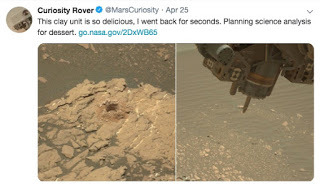 Curiosity Rover on Mars keeping it real.
Curiosity Rover on Mars keeping it real.
Percival Lowell, in sheer delight at these developments, might have sat bolt upright if he wasn't dead under a concrete slab in a mausoleum his thoroughly irritated widow put him beneath on his observatory mountain. Mars was in again! Let's go!
 Constance Lowell at Percival's Mausoleum
Constance Lowell at Percival's Mausoleum
"Hey there! How ya doin'?
I had Wrexi thrown in the street, just so you know!
I also sued your Observatory for its last dime! Have a nice death!"And so the Martian myth came alive yet again just as NASA's space shuttle program was shut down for being too expensive and too dangerous, and its International Space Station, otherwise a magnificent construction, was unfortunately, no matter how one looked at it, adding very little to science and essentially nothing to the economy and therefore needed to pitched just like Apollo was (I will resist putting another photo of The Thinker here).
But when reality fails, dreams can substitute. The Lowellian fantasy floated right back into people's heads. We need to go to Mars! Soon, children picked up on what the adults at NASA were saying and little red planets began to circle their heads. Noticing, NASA public relations folks changed We need to go to Mars! to We're going to Mars! And then after praise came their way for their declaration, there came a shazam! realization within the old agency that, to continue that praise, the leaders there didn't actually have to do the hard work of building anything to go to Mars! It only had to say it was going and people, especially young people, adored them and their agency! So they kept saying it and saying it and pretty soon the highnesses of NASA came to believe it, too. We're going to Mars!
 We're going to Mars!
We're going to Mars!
But, while they were saying it, NASA did nothing to make it a reality. Not. A. Thing.
Accepting for the moment that humans need to go to this small, reddish, essentially airless and radiation-washed planet because it's just marvelous there, what needs to be done so that we complex organisms who get sick and die on Mount Everest (Disney World compared to Mars) might actually go and live there? Well, let's list some of them and see where we are.
1. Testing of habitats large enough to sustain a crew for two years going and coming. - Nothing accomplished or even proposed.*
2. Testing of habitats that would sustain humans on an airless, radiation-washed planet for any length of time - Nothing accomplished or even proposed.
3. Testing of Martian landers. - Nothing accomplished or even proposed.
4. Testing of artificial gravity in order to ameliorate the harmful effects of long-term microgravity (use of centrifugal forces?) - Nothing accomplished or even proposed.*
5. Testing of shielding or medicine to ameliorate the harmful effects of radiation during spaceflight or the Martian surface - Nothing accomplished or even proposed.*
6. Testing of power sources on the Martian surface (nuclear and solar generators?) - Nothing accomplished but some proposals with minor funding and relaxed schedules.
7. Testing of advanced propulsion systems to ameliorate long journey across the nothingness between Earth and Mars (nuclear?) - Nothing accomplished but some proposals with minor funding and relaxed schedules.
* Could have been tested on the International Space Station but wasn't which tells the tale I'm getting at very well.
 Mars Plans? We don't have no stinkin' Mars Plans!
Mars Plans? We don't have no stinkin' Mars Plans!
I could go on but I think the point is made. NASA has accomplished essentially nothing to get ready to send humans to Mars and there is virtually nothing in the pipeline. Still and yet, they keep saying We're going to Mars! even while being ordered to instead go to the moon. Well, actually, that command has forced them to modify their battlecry by putting it this way: We're going to the moon so we can go to Mars! Uh huh, right.
By the way, not talking about Elon here. That boy might just give it a go but that's on his dime which probably has the head of Percival Lowell on it rather than President Roosevelt's. Do it, Mr. Musk. I will cheer you on. Glad you liked The Dinosaur Hunter, by the way.
 Elon reading The Dinosaur Hunter and being thoroughly amused.
Elon reading The Dinosaur Hunter and being thoroughly amused.
And speaking of me...
Just about everyone who pays the slightest bit of attention to my writing about space (a small percentage of my literary output but still...) knows that I am a hopeless human domiciliary lunaphile (that means I love the idea of people living on the moon and doesn't mean something bad) and believe that we as a civilization have much productive work scientifically and economically to do on the planet that circles us.
 My trilogy of moon books, not counting Back to the Moon
My trilogy of moon books, not counting Back to the Moon
 My book the Vice President likes.
My book the Vice President likes.
In fact, I believe the moon is vastly more important to us as a species than Mars will ever be. By utilizing the resources of our nearby neighbor, we can create a spacefaring civilization that, for decades to come, will be mostly back and forth between us and our newly installed lunar brethren and sisteren. But to build what we need on the moon and properly explore it, we're going to have to do a lot of work while not being distracted by that shiny Lowellian object known as Mars.
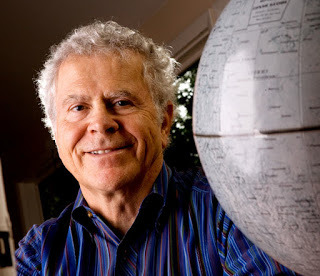 Moi and my favorite planet not counting the one I'm presently on.So, NASA and Mr. Bridenstine, sorry for being fussy but let's go to the place where we need to go for economic as well as scientific reasons and please stop saying it's only so we can go to Mars. It's a big fib and an unnecessary one at that. I absolutely believe Mars should be explored by the federal government's space agency but by robots and AI which every year get better and better and are extensions of we humans, anyway. They'll get us all the information we need and, after all, that's all you're really planning to do so let's stay real and let Dr. Lowell rest.
Moi and my favorite planet not counting the one I'm presently on.So, NASA and Mr. Bridenstine, sorry for being fussy but let's go to the place where we need to go for economic as well as scientific reasons and please stop saying it's only so we can go to Mars. It's a big fib and an unnecessary one at that. I absolutely believe Mars should be explored by the federal government's space agency but by robots and AI which every year get better and better and are extensions of we humans, anyway. They'll get us all the information we need and, after all, that's all you're really planning to do so let's stay real and let Dr. Lowell rest.
 Quote from Percival Lowell on his mausoleumBut I'm not as certain we should let Wrexi rest. That woman deserves a medal for putting up with Percival and winning honors for her astronomical work. How about a Wrexi Leonard Avenue?
Quote from Percival Lowell on his mausoleumBut I'm not as certain we should let Wrexi rest. That woman deserves a medal for putting up with Percival and winning honors for her astronomical work. How about a Wrexi Leonard Avenue?
 Miss Wrexi Leonard,
Miss Wrexi Leonard,
the first professional female astronomer in the United States
Thank you,
Homer
Many of you know that I've recently taken NASA Administrator Jim Bridenstine and other highnesses in the agency to task for not being able to talk about plans to go back to the moon (this time to stay) without mentioning Mars in the same breath. My unhappiness over this tendency is pretty simple: Not only do I not like being told a myth unless the teller is a Tolkien type of tall tale spinner, I don't like young people to be the victim of untruths told again and again until even the non-truth sayers think they're telling the truth.
 Mr. Tolkien, Myth-Teller, whose wonderful books were fiction.
Mr. Tolkien, Myth-Teller, whose wonderful books were fiction.So here is the truth: NASA has no plans now, nor has it ever had plans, nor does it have a plan to have plans to send humans to Mars. As of right now, it isn't going, not with humans, and if you're depending on NASA to get you there, you are going to have a very long wait, sorry. I'll list below some of the things the agency would have done already if it was going to send humans to Mars and they've done none of them.
NASA Aministrator Jim Bridenstine is a very nice man and a competent manager and also very smart. I know him and admire and respect him. But if all that is so, why does he and others in NASA and nearly every person who has anything to do with human spaceflight in the federal government keep talking about going to Mars when they have orders to go to the moon? One reason is because they are victims of an illusion promoted by a billionaire astronomer - sort of a star-gazing Bernie Madoff - more than a century ago that just won't go away. Let me explain why that is as best as I am able in a very short manner which admittedly might miss a few nuances, and let me also provide evidence to you why this astronauts to Mars thing is all a hoax even though the hoaxers (including the original one) don't necessarily understand they're hoaxers and may even think they are telling the truth (bless their hearts).
 Here is Don Knotts, a fellow West Virginian, playing an astronaut
Here is Don Knotts, a fellow West Virginian, playing an astronautthat I'm including just because...
Recently, I had cause to research for a screenplay one Clyde Tombaugh, a nerdy but persistent fellow who discovered the dwarf planet Pluto in 1929 (just in time for the Depression but hey).
 Clyde TombaughIn the process of studying Clyde's experiences, I ran across another interesting story, that of Percival Lowell and his secretary and mistress Wrexi Leonard who would become the first American female professional astronomer.
Clyde TombaughIn the process of studying Clyde's experiences, I ran across another interesting story, that of Percival Lowell and his secretary and mistress Wrexi Leonard who would become the first American female professional astronomer. Percival Lowell at his telescope in his observatory
Percival Lowell at his telescope in his observatory Wrexi Leonard making her own independent observations
Wrexi Leonard making her own independent observationsat the Lowell Observatory
Dr. Lowell was a very rich member of the Lowell family, a bunch of Boston Brahmins who were rumored to only talk to the Cabots who only talked to God. His sister was a cigar-smoking poet and also an avowed Lesbian (this was during the Gilded Age when Victorian mores were still in effect so she truly didn't care what anybody thought). His brother was the President of Harvard.
 Amy Lowell, Percival's sisterWith such siblings, I guess you could say that Percival came from interesting stock. On the other hand, when you're as rich as the Lowells were, I suppose being interesting might be somewhat natural.
Amy Lowell, Percival's sisterWith such siblings, I guess you could say that Percival came from interesting stock. On the other hand, when you're as rich as the Lowells were, I suppose being interesting might be somewhat natural.Anyway, after exploring the sexual mores of the ladies of Asia and writing titillating memoirs about his experiences, Percival decided his next pursuit of the good life was to become an astronomer. He therefore constructed the Lowell Observatory in Arizona, dragged poor Wrexi out there with him, and got to work. Before long, he discovered Mars. Well, not really, as the planet had been known since ancient times but sort of because he saw it in ways nobody had ever seen it before.
 One of Percival Lowell's many drawings of Mars
One of Percival Lowell's many drawings of MarsDr. Lowell (an honorary title) studied Mars every time the clouds cleared from his hilltop observatory above Scottsdale. It wasn't long before he saw some odd features on the red planet and the more he looked at them and drew them, the more he was convinced he was seeing signs of present or past intelligent life. Night after night, he drew what he saw which were lines that streaked across the planet, some of them intersecting in smudgy places as if on purpose. Before long, he was certain that what he was seeing were canals and the intersections were surely oases where the beings who had dug the canals were living. Wrexi (bless her heart) worked very hard to become a competent astronomer and also studied Mars but didn't see what her boss was seeing. Still, she kept her more accurate observations pretty much to herself and praised her Percival for his astonishing ability to see what nobody else could see. That's just the kind of woman she was but, that said, I'm pleased to report she was no passive wallflower. The Mexican and the French Astronomical societies gave her awards for her work.
But back to Percival Lowell.
Armed with what he believed was evidence of Martians building canals to transport water from the poles in order to sustain their civilization which was facing (or had faced) enormous climate change (hmmm...), Lowell wrote many books on these amazing lines and what they meant. He even went on the lecture circuit and, before long, Percival Lowell was something of a pop star of his age and Mars grew into a symbol of life on the edge that was eagerly clasped to its bosom by a repressed society which was thrilled that there was someone out there besides themselves who was probably equally miserable but had done something about it.
 Some books, mostly about Mars, by Percival Lowell
Some books, mostly about Mars, by Percival LowellA careful reading of his writing (difficult as it's pretty dense stuff) shows it isn't entirely clear that Lowell believed his own hype. Actually, he saw that Europe was heading pan over skillet for the Great War and it was his hope that his Martian chronicles would demonstrate that people were better off cooperating in the face of disaster than killing one another off. Nonetheless, the Europeans saw fit to kill one another off by the millions which so disappointed Lowell that he actually died. Well, it may be that something else killed him, maybe his battleaxe of a wife since she was so jealous of Wrexi (my own theory completely devoid and utterly absent of any evidence) but nonetheless Lowell went to the great Mars in the sky, leaving his observatory to struggle on until Clyde showed up but that's another story. Wrexi, by the way, was thrown out on the street by Lowell's wife but did fine other than ending up in the poor house (literally).
 Wrexi's tombstone. She died poor and alone.Lowell's legacy was Mars, or the misunderstanding of what Mars really was, and his purplish prose about what he thought he saw spawned a vast array of fiction including Wells' War of the Worlds, Heinlein's Stranger in a Strange Land, and Bradbury's The Martian Chronicles. Mars in the minds of so many readers became sort of a mini-Earth, or a place where another Earth might rise, and where humans should aspire to go because it was, well, Mars which beckoned with open arms. Besides these literate, exciting books, there came thousands and thousands of tales in book or film form set on a fictional Mars, nearly all of it grown straight out of Percival Lowell's imagination while he peered through his telescopes atop an Arizona mountain (the canals, by the by, might have been the reflection of the veins in his eyes). Lowell's prose was so romantic and his lectures so interesting that, over time, in nearly everyone's head Mars became not what it actually was but what everyone wanted it to be.
Wrexi's tombstone. She died poor and alone.Lowell's legacy was Mars, or the misunderstanding of what Mars really was, and his purplish prose about what he thought he saw spawned a vast array of fiction including Wells' War of the Worlds, Heinlein's Stranger in a Strange Land, and Bradbury's The Martian Chronicles. Mars in the minds of so many readers became sort of a mini-Earth, or a place where another Earth might rise, and where humans should aspire to go because it was, well, Mars which beckoned with open arms. Besides these literate, exciting books, there came thousands and thousands of tales in book or film form set on a fictional Mars, nearly all of it grown straight out of Percival Lowell's imagination while he peered through his telescopes atop an Arizona mountain (the canals, by the by, might have been the reflection of the veins in his eyes). Lowell's prose was so romantic and his lectures so interesting that, over time, in nearly everyone's head Mars became not what it actually was but what everyone wanted it to be. And there you go!But then came a violent correction of Lowell's Martian dreams in the form of the truth.
And there you go!But then came a violent correction of Lowell's Martian dreams in the form of the truth. Mariner IV - Dream SlayerIn 1965, NASA' s Mariner IV flew past Mars and took photos and other measurements. What it sent back shocked scientists and lay people still awash with Lowellian dreams of a ruddy but livable world. The photographs revealed only a tortured plain of craters and dirt. Moreover, the flyby confirmed that the Martian atmosphere was only about 1% of Earth's and almost entirely carbon dioxide. The planet also had no magnetic field. In other words, Mars was a dead planet. Dead, dead, dead.
Mariner IV - Dream SlayerIn 1965, NASA' s Mariner IV flew past Mars and took photos and other measurements. What it sent back shocked scientists and lay people still awash with Lowellian dreams of a ruddy but livable world. The photographs revealed only a tortured plain of craters and dirt. Moreover, the flyby confirmed that the Martian atmosphere was only about 1% of Earth's and almost entirely carbon dioxide. The planet also had no magnetic field. In other words, Mars was a dead planet. Dead, dead, dead. Wait a minute, Mariner IV... Can this be right? This is Mars?The midget planet (only one third the size of Earth) was now known to be nothing but a battered old red rock located far, far away but NASA (bless its heart for persistence) labored on in its study of the place but sadly now with its chastened dreams of a little globe somewhat like Earth totally crushed.
Wait a minute, Mariner IV... Can this be right? This is Mars?The midget planet (only one third the size of Earth) was now known to be nothing but a battered old red rock located far, far away but NASA (bless its heart for persistence) labored on in its study of the place but sadly now with its chastened dreams of a little globe somewhat like Earth totally crushed.Lowell's dreamy depictions of Mars and all the fiction that had been built up around it, however, proved extremely difficult to suspend and, very soon, the ancient red corpse was being resurrected as a place where humans absolutely needed to go. This time, it was by none other than Dr. Wernher von Braun, something of a dreamer himself, who put Mars back up on its pedestal with a rhetorical stick up its back to hold it up. This, oddly enough, was because of the Apollo moon program which, after an initial rush of excitement after the first landing and the thrill of the Apollo 13 rescue, quickly lapsed below the fold in interest by a bored public.
 My cat Wyatt being bored like the American public. I am
My cat Wyatt being bored like the American public. I amincluding this because he's also cute (so is the American public)As an aside, what could have happened at this point was that NASA and the American intelligentsia might have said to themselves, "You know, these Apollo flights have been great and we've learned a lot but they've kind of run their course with the present technology. Let's pause, consider what we've learned, and in the meantime slowly and responsibly build more robust systems to go to the lunar surface so that we might prosper from our success..."
 Thinking like the Thinker, a somewhat untested process in the
Thinking like the Thinker, a somewhat untested process in theUnited States overall space programBut nooooo.
Before we scarcely got there, the moon flights were cancelled along with Dr. von Braun's extremely successful heavy lifting Saturn V rocket. Hurt by this rejection, the doctor latched onto Mars and waxed eloquently on it as a substitute destination. To get there, he conjured up a multi-tiered approach of building a space shuttle, then a space station, and then nuclear rocket engines that would propel twin spacecraft and their landers to the small red planet. He said to anyone who would listen that Mars was the "next moon" and so he prepared his pitch to the powers that be and it was a good one, too.
 Dr. von Braun's Hail Mary Pass to MarsUnfortunately...
Dr. von Braun's Hail Mary Pass to MarsUnfortunately...The day after Dr. von Braun made his presentation on going to Mars to Vice President Agnew (soon to resign for taking bribes) and Congress (nobody resigned even though, well, you know), Mariner VII swept by Mars and revealed, yep, Mariner IV wasn't kidding. Mars was not only dead but it was really, really dead. Von Braun was therefore summarily dismissed, his presentation tossed in the trash can, and any idea of going to Mars was forgotten.
 Thank you, Dr. von Braun.
Thank you, Dr. von Braun.We will consider your proposal carefully - Congress.
But not really. NASA yet persevered, this time in the 1970's with two Viking spacecraft that actually landed on the dusty little planet's surface, one of the experiments even looking for signs of life. The result of that experiment was no life was found... or was it? There was some uncertainty. Over the next few decades, NASA dispatched increasingly sophisticated spacecraft to the small planet for detailed studies. These probes showed Mars to be a lot more interesting than the Mariner and even the Viking missions predicted. It was a world that had once known flowing water and still had polar ice caps, had deep canyons and giant mountains, and was geologically diverse. Moreover, little American robots with cute names began to roam the Martian surface and as they went along, they began to take on personalities and were praised for being brave and hardy and true pioneers.
 Curiosity Rover on Mars keeping it real.
Curiosity Rover on Mars keeping it real.Percival Lowell, in sheer delight at these developments, might have sat bolt upright if he wasn't dead under a concrete slab in a mausoleum his thoroughly irritated widow put him beneath on his observatory mountain. Mars was in again! Let's go!
 Constance Lowell at Percival's Mausoleum
Constance Lowell at Percival's Mausoleum"Hey there! How ya doin'?
I had Wrexi thrown in the street, just so you know!
I also sued your Observatory for its last dime! Have a nice death!"And so the Martian myth came alive yet again just as NASA's space shuttle program was shut down for being too expensive and too dangerous, and its International Space Station, otherwise a magnificent construction, was unfortunately, no matter how one looked at it, adding very little to science and essentially nothing to the economy and therefore needed to pitched just like Apollo was (I will resist putting another photo of The Thinker here).
But when reality fails, dreams can substitute. The Lowellian fantasy floated right back into people's heads. We need to go to Mars! Soon, children picked up on what the adults at NASA were saying and little red planets began to circle their heads. Noticing, NASA public relations folks changed We need to go to Mars! to We're going to Mars! And then after praise came their way for their declaration, there came a shazam! realization within the old agency that, to continue that praise, the leaders there didn't actually have to do the hard work of building anything to go to Mars! It only had to say it was going and people, especially young people, adored them and their agency! So they kept saying it and saying it and pretty soon the highnesses of NASA came to believe it, too. We're going to Mars!
 We're going to Mars!
We're going to Mars!But, while they were saying it, NASA did nothing to make it a reality. Not. A. Thing.
Accepting for the moment that humans need to go to this small, reddish, essentially airless and radiation-washed planet because it's just marvelous there, what needs to be done so that we complex organisms who get sick and die on Mount Everest (Disney World compared to Mars) might actually go and live there? Well, let's list some of them and see where we are.
1. Testing of habitats large enough to sustain a crew for two years going and coming. - Nothing accomplished or even proposed.*
2. Testing of habitats that would sustain humans on an airless, radiation-washed planet for any length of time - Nothing accomplished or even proposed.
3. Testing of Martian landers. - Nothing accomplished or even proposed.
4. Testing of artificial gravity in order to ameliorate the harmful effects of long-term microgravity (use of centrifugal forces?) - Nothing accomplished or even proposed.*
5. Testing of shielding or medicine to ameliorate the harmful effects of radiation during spaceflight or the Martian surface - Nothing accomplished or even proposed.*
6. Testing of power sources on the Martian surface (nuclear and solar generators?) - Nothing accomplished but some proposals with minor funding and relaxed schedules.
7. Testing of advanced propulsion systems to ameliorate long journey across the nothingness between Earth and Mars (nuclear?) - Nothing accomplished but some proposals with minor funding and relaxed schedules.
* Could have been tested on the International Space Station but wasn't which tells the tale I'm getting at very well.
 Mars Plans? We don't have no stinkin' Mars Plans!
Mars Plans? We don't have no stinkin' Mars Plans!I could go on but I think the point is made. NASA has accomplished essentially nothing to get ready to send humans to Mars and there is virtually nothing in the pipeline. Still and yet, they keep saying We're going to Mars! even while being ordered to instead go to the moon. Well, actually, that command has forced them to modify their battlecry by putting it this way: We're going to the moon so we can go to Mars! Uh huh, right.
By the way, not talking about Elon here. That boy might just give it a go but that's on his dime which probably has the head of Percival Lowell on it rather than President Roosevelt's. Do it, Mr. Musk. I will cheer you on. Glad you liked The Dinosaur Hunter, by the way.
 Elon reading The Dinosaur Hunter and being thoroughly amused.
Elon reading The Dinosaur Hunter and being thoroughly amused.And speaking of me...
Just about everyone who pays the slightest bit of attention to my writing about space (a small percentage of my literary output but still...) knows that I am a hopeless human domiciliary lunaphile (that means I love the idea of people living on the moon and doesn't mean something bad) and believe that we as a civilization have much productive work scientifically and economically to do on the planet that circles us.
 My trilogy of moon books, not counting Back to the Moon
My trilogy of moon books, not counting Back to the Moon
 My book the Vice President likes.
My book the Vice President likes.In fact, I believe the moon is vastly more important to us as a species than Mars will ever be. By utilizing the resources of our nearby neighbor, we can create a spacefaring civilization that, for decades to come, will be mostly back and forth between us and our newly installed lunar brethren and sisteren. But to build what we need on the moon and properly explore it, we're going to have to do a lot of work while not being distracted by that shiny Lowellian object known as Mars.
 Moi and my favorite planet not counting the one I'm presently on.So, NASA and Mr. Bridenstine, sorry for being fussy but let's go to the place where we need to go for economic as well as scientific reasons and please stop saying it's only so we can go to Mars. It's a big fib and an unnecessary one at that. I absolutely believe Mars should be explored by the federal government's space agency but by robots and AI which every year get better and better and are extensions of we humans, anyway. They'll get us all the information we need and, after all, that's all you're really planning to do so let's stay real and let Dr. Lowell rest.
Moi and my favorite planet not counting the one I'm presently on.So, NASA and Mr. Bridenstine, sorry for being fussy but let's go to the place where we need to go for economic as well as scientific reasons and please stop saying it's only so we can go to Mars. It's a big fib and an unnecessary one at that. I absolutely believe Mars should be explored by the federal government's space agency but by robots and AI which every year get better and better and are extensions of we humans, anyway. They'll get us all the information we need and, after all, that's all you're really planning to do so let's stay real and let Dr. Lowell rest. Quote from Percival Lowell on his mausoleumBut I'm not as certain we should let Wrexi rest. That woman deserves a medal for putting up with Percival and winning honors for her astronomical work. How about a Wrexi Leonard Avenue?
Quote from Percival Lowell on his mausoleumBut I'm not as certain we should let Wrexi rest. That woman deserves a medal for putting up with Percival and winning honors for her astronomical work. How about a Wrexi Leonard Avenue? Miss Wrexi Leonard,
Miss Wrexi Leonard,the first professional female astronomer in the United States
Thank you,
Homer
Published on June 13, 2019 16:24
date newest »
newest »
 newest »
newest »
message 1:
by
Richard
(new)
Jun 14, 2019 11:56AM
 I was thoroughly entertained while reading this. I always thought the same thing concerning a mission to Mars: it was a farce.
I was thoroughly entertained while reading this. I always thought the same thing concerning a mission to Mars: it was a farce.
reply
|
flag
 I enjoyed reading this blog. Thank you. However, I am curious as to why you said that Lowell Observatory sat on a mountain above Scottsdale. The Observatory is (and always has been, as far as I am aware) sitting on a mountain above Flagstaff, some 150 miles from Scottsdale. That would be like saying that the Midway is located off the coast of Los Angeles as opposed to San Diego. Not an accurate representation of the location.
I enjoyed reading this blog. Thank you. However, I am curious as to why you said that Lowell Observatory sat on a mountain above Scottsdale. The Observatory is (and always has been, as far as I am aware) sitting on a mountain above Flagstaff, some 150 miles from Scottsdale. That would be like saying that the Midway is located off the coast of Los Angeles as opposed to San Diego. Not an accurate representation of the location.



